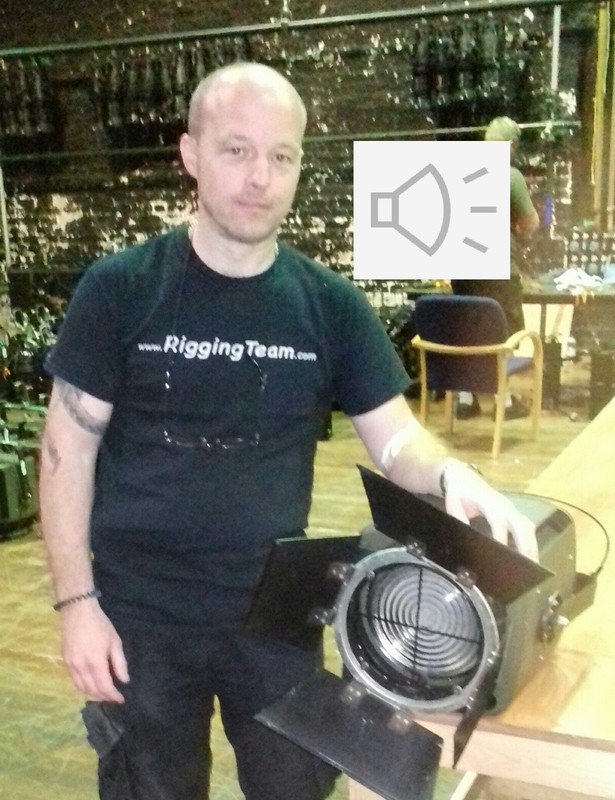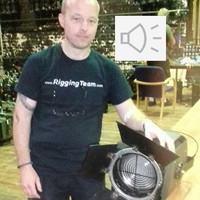Title
Michael Donoghue Interview: Technical Changes Over the Years
Date
3 August 2018
Description
Oral history interview with Michael Donoghue, Head of Sound & Lighting at the Theatre Royal.
What's the story?
Born in London and involved in amateur theatre as a performer in his early years, Michael Donoghue ‘ditched’ his A levels to work professionally in the theatre. At the tender age of nineteen, in 1991 he moved to Nottingham to work as a lighting technician at the Theatre Royal.
Having clearly learnt ‘on the job’ Michael is now Head of Sound & Lighting at the venue, managing an extremely busy department.
In this interview Michael discusses the main technical changes concerning sound, lighting and staging over the years, including the need to have bigger West End sets and the need to ‘mic’ performers, even for dramas.
For sound, for most shows a lot of it would have just been live and people would have been expected to just project. But as people’s expectations have grown more and more, and are more and more used to just sitting at home or in the cinema and having the sound wash over them, sitting in an auditorium in a theatre and having to sit quietly and listen carefully to dialogue; people aren’t as interested in that any more. So, quite often, people are mic’d up. Even sometimes now on plays, people will be wearing microphones, which never used to happen in the past. It does happen quite a lot when you get TV celebrities that are in theatre shows that just aren’t used to having to project. Sometimes they get mic’d up.
Sound effects for shows, even on a play, when I first started people would turn up with their big reels of tape and they would give that to me or one of the other guys at the beginning the week and we’d have to go and lace it up. We’d be given a cue sheet and would have to operate that ourselves, set all the levels and everything for each performance, whereas nowadays all the sound effects are on a computer, so the DSM would probably have the computer with him in the prompt corner and they would give us two cables that would plug into our front of house speakers, just give us a left and right feed and then they would just have a button that they press and because everything’s pre-recorded and all the levels are set, they’ll change the overall level to balance for the differences in your theatre, but the DSM would do it themselves nowadays.
I think stagewise things have just got bigger. Sets have got more complex,. They want their West End look for every show they come and see. So quite often it’s a West End set that’s being toured around the country, which has its downsides, because a lot of the time they’re not built to tour. There’s a big difference between a set that’s designed to be put up and taken down every week. The way it’s put together and built is more sympathetic to it happening once a week, whereas a show that’s been built to go into the West End, in theory has been built to just be put together and left on the stage for however many years. So that can make a difference as well.
Lights have changed hugely over the years. Although the basic premise is just the same. Most lights are a light bulb, a reflector behind it and a lens in front of it, to be able to focus the light wherever you need it. But nowadays, obviously, there’s what we call “moving lights” that you can program in the lighting desk to go to different positions So before now, where you might need six lights because they’ll all at different places, you can nowadays do it with one light because it can move itself to the different positions for each different scene.
Having clearly learnt ‘on the job’ Michael is now Head of Sound & Lighting at the venue, managing an extremely busy department.
In this interview Michael discusses the main technical changes concerning sound, lighting and staging over the years, including the need to have bigger West End sets and the need to ‘mic’ performers, even for dramas.
For sound, for most shows a lot of it would have just been live and people would have been expected to just project. But as people’s expectations have grown more and more, and are more and more used to just sitting at home or in the cinema and having the sound wash over them, sitting in an auditorium in a theatre and having to sit quietly and listen carefully to dialogue; people aren’t as interested in that any more. So, quite often, people are mic’d up. Even sometimes now on plays, people will be wearing microphones, which never used to happen in the past. It does happen quite a lot when you get TV celebrities that are in theatre shows that just aren’t used to having to project. Sometimes they get mic’d up.
Sound effects for shows, even on a play, when I first started people would turn up with their big reels of tape and they would give that to me or one of the other guys at the beginning the week and we’d have to go and lace it up. We’d be given a cue sheet and would have to operate that ourselves, set all the levels and everything for each performance, whereas nowadays all the sound effects are on a computer, so the DSM would probably have the computer with him in the prompt corner and they would give us two cables that would plug into our front of house speakers, just give us a left and right feed and then they would just have a button that they press and because everything’s pre-recorded and all the levels are set, they’ll change the overall level to balance for the differences in your theatre, but the DSM would do it themselves nowadays.
I think stagewise things have just got bigger. Sets have got more complex,. They want their West End look for every show they come and see. So quite often it’s a West End set that’s being toured around the country, which has its downsides, because a lot of the time they’re not built to tour. There’s a big difference between a set that’s designed to be put up and taken down every week. The way it’s put together and built is more sympathetic to it happening once a week, whereas a show that’s been built to go into the West End, in theory has been built to just be put together and left on the stage for however many years. So that can make a difference as well.
Lights have changed hugely over the years. Although the basic premise is just the same. Most lights are a light bulb, a reflector behind it and a lens in front of it, to be able to focus the light wherever you need it. But nowadays, obviously, there’s what we call “moving lights” that you can program in the lighting desk to go to different positions So before now, where you might need six lights because they’ll all at different places, you can nowadays do it with one light because it can move itself to the different positions for each different scene.
Type
Oral interview
Location of item
Theatre Royal & Royal Concert Hall Nottingham
Rights
Theatre Royal & Royal Concert Hall Nottingham
Contributor
Interviewers: Jennifer Sherwood & Diane Jones
Transcriber: David Chilton
Transcriber: David Chilton



